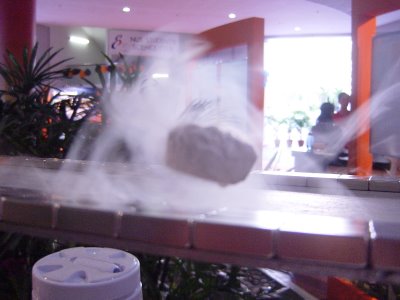Here's some fresh photos from Sunday:


What's that? A mutant swan that can defy gravity?
Nah! That's the superconductor experiment at the physics booth. I've been playing that for most of the time I'm there. As expected, it never fails to capture the attention of the many people around.
Take a closer look at a (more appropriately shaped) superconductor:



A quick lesson on why superconductors can levitate above a magnetic track:
Firstly, a superconductor is made of a very special type of ceramic (can't remember the name; it's very long), which, when cooled below a certain temperature, will exhibit superconductivity. Superconductivity means that when a current flows through the material, it encounters zero resistance. Completely zero.
So when the superconductor is placed on a magnetic track, it will fall (due to gravity) until a point whereby the magnetic field is strong enough (doesn't have to be super-strong, for that matter) such that it is sufficient to counter the gravitational force.
But how does this magnetic field create a "repulsion"? This is due to Lenz's Law, which states that a changing magnetic flux will induce a current (or e.m.f., whichever you like) that will produce a magnetic field to oppose the change). So if the superconductor were to fall, it will cut the magnetic field lines, so according to Lenz's Law, it will be "repelled" upwards. Don't forget that the superconductor has no resistance, so the current induced will be large and so will the magnetic field strength created to oppose the change. In some sense, it is something like 100% efficiency.
(Actually, this is not the correct explanation, but it is the best I can give without going too technical.)
How come I put quotes on the words "repulsion" and "repelled" above? That is because it is not necessary repulsion that is generated. I can turn the track upside down (it's a pity I did not take a picture of that) and the superconductor will still "levitate" below the track, because to fall out of the track will induce a change in magnetic flux which will oppose the change (of course I must push it closer to the track so that the magnetic field strength is strong enough to overcome gravity). Likewise, when the superconductor reaches the bend, it will cut the field lines, so it will be kept in the track and bank around the corner. Of course, if the superconductor is going too fast, it will fly out of the track, which happened an awful lot of times (because I was too eager to make it go as fast as possible).
Actually, the superconductor is black in colour, but it is wrapped in alumnimium foil so that it can trap the liquid nitrogen used to cool it, and thus last very long. In fact, I've tried to see how long it can last, and it went 37 times around the track.
Anyway, here's a demonstration of "setting off" the superconductor:
1) Take the superconductor.

2) Get some liquid nitrogen (-200 °C).

3) Put the superconductor in the liquid nitrogen (notice that the liquid nitrogen is boiling, but it is actually very very cold).

4) Use the wooden tongs to take out the superconductor (unless you don't mind getting frostbites).

5) Put it on a magnetic track (notice the keys).

Tada! A levitating superconductor!

No strings attached!

A superconductor speeding around the track (taken in the demo lab):

Okay. One superconductor. One track. A hell lot of liquid nitrogen. So what do we do? The natural thing happens.
We play with them.
We put them into water:

I put some on my shirt (absolutely cool):

I put a bit in a drink carton and suck the "smoke" out.

Hehe... that was a hell lot of fun with superconductors. We did a lot more, in fact, but I did not take pictures of them.
But that's not all. The physics demo lab has many more toys. Here's a few of my favourites.
Mirage bowls:


Plasma ball:

Static electricity generator:

Water swirl (note the almost straight column of whirlpool instead of the normal bubbles we usually see):

Whee... That's a lot of fun, and a lot of time spent. Absolutely intriguing. That's why I like physics.
Time to catch up with my homework!






No comments:
Post a Comment